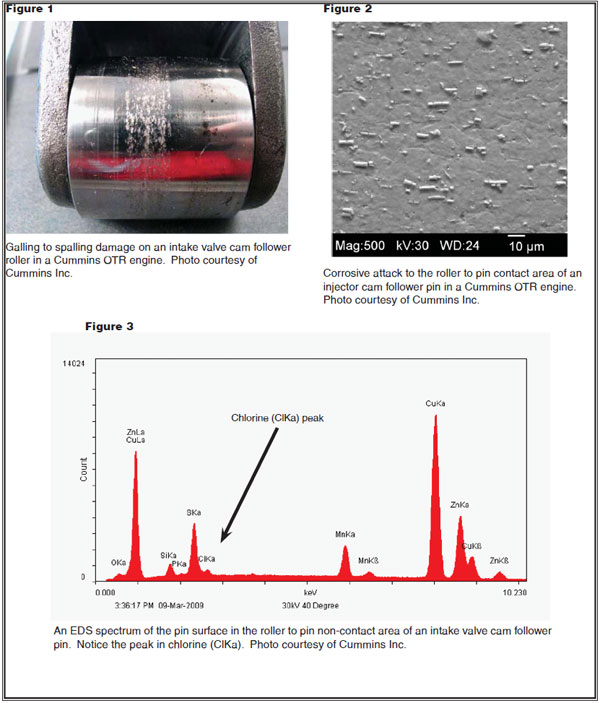 |
|
|
Chlorine-containing potentially corrosive aftermarket engine oil treatmentsISSUES: The use of aftermarket engine oil supplements that contain chlorine can cause corrosive wear to a vehicle’s engine and possible subsequent engine failure. TECHNICAL DISCUSSION: Aftermarket engine oil supplements are “treatments” advertised to enhance an oil’s properties. Manufacturers claim these treatments reduce friction, noise and wear; maintain higher lubricity and break down sludge and varnish, protecting the engine components. Many products advertise materials like Tefl on, molybdenum or graphite; however, most fail to mention that they contain chlorine, which can be highly corrosive when mixed with water. Chlorinated paraffi ns were once used as extreme pressure (EP) additives in lubricants, but the practice has been discontinued in most passenger vehicle lubricants due to the corrosive side effects. These chlorinated compounds are used due to their low cost and ability to provide EP properties, but they readily react with water and combustion by-products to form acidic materials that promote corrosion of engine components and bearings. Lubes ‘N’ Greases published an article in August 1998 outlining the effects of chlorine on vehicle engine components. Author Maurice LePera explains the following: Chlorinated additives are not used in modern, fully formulated automotive engine oils. The environment within an internal combustion engine consists of high operating temperatures, combustion and blowby gases, moisture, acid and oxidation precursors, wear debris, unburnt fuel, etc. The combination of these ingredients when combined with the catalytic effects of metallic surfaces and trace soluble metals such as copper will cause chlorine to hydrolyze – forming hydrochloric acid and other associated reaction products. Once generated, these acidic reaction products can cause serious internal engine corrosion problems, especially on ferrous and aluminum alloys.1 Furthermore, chlorinated paraffins tend to become more reactive as temperatures rise, making them exponentially more dangerous in hotter environments. “Chlorine-based additives can be film-forming even at ambient temperatures, but as the temperature rises they become aggressive and, with the release of HCl [hydrochloric acid], can cause signifi cant corrosion.”2 Corrosion on the cam lobe or tappet face can also cause corrosive spalling, outlined in an engine failure case later in this bulletin. Because of the side effects of chlorine breakdown, many military and commercial specifications prohibit the use of chlorinated additives. For example, military specification MIL-PRF-17331J specifies, “[additives], if used, shall not contain chlorine.”3 Furthermore, “SAE J357 (Physical and Chemical Properties of Engine Oils) lists chlorine as a contaminant.”1 AMSOIL INC. recently initiated an independent lab study to determine if four engine treatment products contained chlorinated ingredients, and if so, how much each contained. The products tested were Dura Lube Engine Treatment Booster, Motorkote Hyper Lubricant/Engine Treatment, Motorkote MK Million Mile Formula and Prolong Engine Treatment. Dura Lube4 and Prolong6 make no reference to chlorine content in their product descriptions; Motorkote5 makes no reference in some of their product descriptions, while others specifi cally state “contains no chlorine.” However, based on the lab testing, each contains high amounts of chlorine as referenced in the following table.
Each oil additive contained signifi cant quantities of chlorine as tested by ASTM D-808. Typical lubricating fl uids contain anywhere from 0 to 150 ppm of chlorine, which is considered a trace amount. A recent AMSOIL Technical Services investigation on a Cummins OTR ISX-485 engine failure revealed a high amount of chlorine in the engine oil. The Cummins parts analysis determined the engine failure was the result of a corrosive attack to the cam follower pins, causing valve and injector camshaft lobe failures (see Figures 1-2). Five injector lobes and four valve lobes were significantly spalled, meaning the metal flaked off the surface of the lobes. Analysis of the injector pin and valve pin showed corrosive attack in both the wear and non-wear areas of the pins, while severe galling was observed on the cams and cam follower pins. Galling is the transference of material when moving parts are no longer fully separated and protected. Furthermore, surface analysis showed peaks of chlorine in the actual metal surface, which is not normally present on a cam follower pin under normal operating conditions (see Figure 3).
The chemical data on the lubricant and surface analysis of the failed engine parts revealed the root cause of the failure was corrosive wear. Acidic components in lubricants directly lead to corrosive wear. In this case, an abnormal amount of chlorine was found in the engine oil. Chlorine, when combined with hydrogen and water in the engine, can create hydrochloric acid. This, in turn, can cause severe TBN depletion, which was the case with this Cummins engine. It was determined that a chlorine-containing additive was used when an oil sample from the engine tested at 11,000 ppm of chlorine. The result was an extreme corrosive environment which was responsible for the upper end engine failure within 195,000 original miles. RECOMMENDATION: Aftermarket oil additives are not recommended for use with AMSOIL synthetic motor oils. AMSOIL synthetic motor oils are fully formulated to provide superior protection and performance; use of aftermarket additives will detract from their performance and possibly lead to engine failure. Use of aftermarket oil additives not approved by AMSOIL INC. will void the AMSOIL Limited Warranty. REFERENCES: 1. LePera, Maurice. (1998, August). Chlorine & Engine Oils: A Good Mix? Lubes ‘N’ Greases, pp. 16-20. 2. Rudnick, Leslie R. (2003). Lubricant Additives Chemistry and Applications. New York, New York: Marcel Dekker, Inc. 3. MIL-PRF-17331J. (2003, September 09). Retrieved from http://www.wbdg.org/ccb/FEDMIL/prf17331j.pdf. 4. Dura Lube Products. (2008). Retrieved from https://www.duralube.com/Galleries/Small/DL%20booster%20sell%20sheet.pdf. 5. Motorkote Products. (2008). Retrieved from https://www.motorkote.com/Products.aspx. 6. Prolong Super Lubricants. (2010). Retrieved from http://www.prolong.com/A_ET.html. |
| AMSOIL Online Store | AMSOIL Products | AMSOIL FAQ's | Altrum - Aggrand Products | Copyright | Contact Us | ©2005-2012 Woods Bros. Racing |  |
| Links | Site Map | Return Policy | Privacy Policy | Disclaimer |
